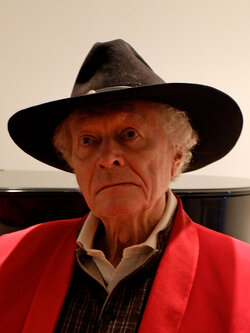Gerry Fisher is not dead
By Pierre-William Glenn, AFCHe was granted this special dispensation and I was very surprised to be offered the position of cameraman, with the same status as Gerry, on a film that the French and international critics acclaimed as a masterpiece. I was delighted to be offered the possibility of working with one of the best Directors of Photography of the twentieth century, while he was working with one of the best Directors of our era.
It was a fantastic experience, every minute was creative, from the preparation for shooting to the grading. I learned the traditional method of handling direct lighting, as practised by Black and White cinematographers, and a modern method of using diffused lighting. Gerry was totally uncompromising, very demanding and quite simply brilliant when it came to interpreting the scenery, whether it was in a studio or a natural décor. His genius also showed in his availability and speed of reaction.
Losey’s working method was based on trust and the freedom he afforded his colleagues. My privileged observation post undoubtedly allowed me to gain much experience at a time when know-how was not passed on lightly, when technical secrecy ruled, when the position of Director of Photography was more or less black magic and when the cameraman was the only person who actually saw the scene. At a time when there were no “control monitors” cluttering up the workplace, we worked in an atmosphere of trust and deep, mutual respect.
Gerry enjoyed a challenge. His electrical installations were diabolically accurate and, as a highly skilled cameraman himself, he imposed camera movements that were as precise as his lighting ; I often had to manoeuvre around spotlights touching every edge of the frame during a sequence shot. The admiration and the friendship that developed during our adventure lasted to the end. I worked again with him – under the same conditions – on Like a Boomerang, by José Giovanni and on Roads to the South, by Joseph Losey, with my full team and the same pleasure in re-discovering a talent that never ceased to astound me.
Gerry was a worthy representative of the prestigious BSC (British Society of Cinematographers) founded in 1949 and which “wrote” the most beautiful pages of our craft with creators of light such as Jack Cardiff, Guy Green, Christopher Challis, Douglas Slocombe, Jack Hildyard, Chris Menges, Oswald Morris, Nicolas Roeg, Geoffrey Unsworth and Freddie Young who were all references for me, but this list is far from exhaustive. Just like his prestigious colleagues, Gerry was almost a caricature of an Englishman : he always dressed with aristocratic elegance and he had an innate understanding of hierarchy. He was confident of his talent, tough against pain and very tenacious (“We are not giving up”, he would often tell me, with a sense of humour bordering on perversity).
He was also very fond of France and its art de vivre. He maintained his friendship and respect for the many French photographic technicians who were lucky enough to work with him. Gerald Fisher was a sort of go-between for “French tradition” and “English tradition” and it is symptomatic that Joseph Losey called alternately upon Henri Alekan and Gerry Fisher for his films.
Let’s hope that his demanding nature with regard to the quality of storytelling, integrity and respect for creative work will be defended as ardently by future generations of Directors of Photography. It would be the best homage we could pay him and it will guarantee he lives on.
To paraphrase Pierre Schoendoerffer speaking about the death of a great actor, I would say that “great Directors of Photography do not die, they move on…”
 En
En Fr
Fr





